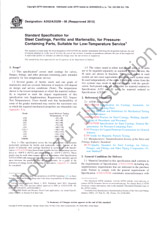Wir benötigen Ihre Einwilligung zur Verwendung der einzelnen Daten, damit Sie unter anderem Informationen zu Ihren Interessen einsehen können. Klicken Sie auf "OK", um Ihre Zustimmung zu erteilen.
ASTM E3220-20
Standard Guide for Characterization of Graphene Flakes
Name übersetzen
NORM herausgegeben am 1.4.2020
Informationen über die Norm:
Bezeichnung normen: ASTM E3220-20
Anmerkung: UNGÜLTIG
Ausgabedatum normen: 1.4.2020
SKU: NS-993183
Zahl der Seiten: 13
Gewicht ca.: 39 g (0.09 Pfund)
Land: Amerikanische technische Norm
Kategorie: Technische Normen ASTM
Die Annotation des Normtextes ASTM E3220-20 :
Keywords:
atomic force microscopy, graphene, graphene oxide, Raman spectroscopy, X-ray photoelectron spectroscopy,, ICS Number Code 59.100.20 (Carbon materials)
Ergänzende Informationen
| Significance and Use |
|
4.1 The remarkable structural, physical and chemical properties of graphene — particularly its mechanical strength, high electronic mobility, lightness, and transparency (single layer or a few layers) — have generated worldwide research and industrial production efforts aimed at developing practical applications. Various industrially scalable production methods have been developed, including bottom-up approaches that grow graphene from small molecules (with or without a substrate), and top-down methods that start with graphite and exfoliate it by mechanical, chemical or electrochemical methods to produce nanoscale product such as graphene flakes. Two common exfoliation methods are: (4.2 It should be noted that these materials and products may exist in either a powder or dispersion (in liquid) form. Other techniques and measurements (ISO/TR 18196:2016) such as X-ray diffraction (XRD), optical microscopy, scanning electron microscopy (SEM), transmission electron microscopy (TEM) and surface area measurement, can also be used for characterization of graphene and related products but discussion of these methods is beyond the scope of this guide. |
| 1. Scope |
|
1.1 This standard will provide guidance on the measurement approaches for assessment of lateral flake size, average flake thickness, Raman intensity ratio of the D to G bands, and carbon/oxygen ratio for graphene and related products. The techniques included here are atomic force microscopy, Raman spectroscopy and X-ray photoelectron spectroscopy. Examples will be given for each type of measurement. 1.2 This guide is intended to serve as an example for manufacturers, producers, analysts, and others with an interest in graphene and related products such as graphene oxide and reduced graphene oxide. This Standard Guide is not intended to be a comprehensive overview of all possible characterization methods. 1.3 This guide does not include all sample preparation procedures for all possible materials and applications. The user must validate the appropriateness for their particular application. 1.4 The values stated in SI units are to be regarded as standard. No other units of measurement are included in this standard. 1.5 This standard does not purport to address all of the safety concerns, if any, associated with its use. It is the responsibility of the user of this standard to establish appropriate safety, health, and environmental practices and determine the applicability of regulatory limitations prior to use. 1.6 This international standard was developed in accordance with internationally recognized principles on standardization established in the Decision on Principles for the Development of International Standards, Guides and Recommendations issued by the World Trade Organization Technical Barriers to Trade (TBT) Committee. |
Empfehlungen:
Aktualisierung der technischen Normen
Wollen Sie sich sicher sein, dass Sie nur die gültigen technischen Normen verwenden?
Wir bieten Ihnen eine Lösung, die Ihnen eine Monatsübersicht über die Aktualität der von Ihnen angewandten Normen sicher stellt.
Brauchen Sie mehr Informationen? Sehen Sie sich diese Seite an.




 Cookies
Cookies
